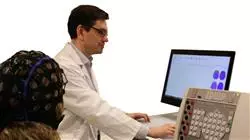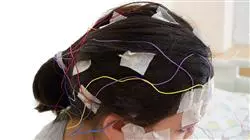University certificate
The world's largest faculty of medicine”
Description
Master electroencephalograms and prove that you are a physician capable of meeting even greater healthcare challenges"

A medical professional who aspires to major professional improvements should look for a demanded and current specialization, with which to stand out from his or her colleagues. Clinical neurophysiology, and more specifically electroencephalograms, are often overlooked when looking for a particular specialty given their common use for the diagnosis of various pathologies.
But this is precisely its strong and attractive point for the medical professional who wants to stand out, because having a full understanding of the most intrinsic and detailed aspects of encephalograms, they will quickly become an essential part of the healthcare organization chart in which they find themselves.
This TECH postgraduate certificate brings together, therefore, an extensive and complete syllabus ranging from standard protocols and maneuvers for performing EGG to slow and epileptiform anomalies that the professional may encounter. It also focuses on quantified EGG, a current method that requires state-of-the-art software to see the dynamic changes that occur during cognitive processing tasks, giving the clinician the ability to identify which areas of the brain may be compromised and which are functioning properly.
A completely online program that adapts to the needs of its students, giving them the possibility of taking it completely at their own pace and specific needs. The student has access to all the didactic material from the first day of the postgraduate certificate, being able to download it to any device with internet access.
You will be prepared to know how to recognize any abnormalities in the EEGs you perform, which will make you vital to your healthcare team"
This postgraduate certificate in Brain Electrogenesis. Recording and Analysis Techniques. Electroencephalogram Development contains the most complete and up to date educational program on the market. The most important features include:
- The development of case studies presented by medical experts in neurophysiology and electroencephalograms
- The graphic, schematic, and eminently practical contents with which they are created, provide scientific and practical information on the disciplines that are essential for professional practice
- Practical exercises where self-assessment can be used to improve learning
- Its special emphasis on innovative methodologies
- Theoretical lessons, questions to the expert, debate forums on controversial topics, and individual reflection assignments
- Content that is accessible from any fixed or portable device with an Internet connection
Your own staff will benefit from having you as a reference when performing EGG on all kinds of patients"
The program’s teaching staff includes professionals from the sector who contribute their work experience to this training program, as well as renowned specialists from leading societies and prestigious universities.
The multimedia content, developed with the latest educational technology, will provide the professional with situated and contextual learning, i.e., a simulated environment that will provide immersive training programmed to train in real situations.
The design of this Program focuses on Problem-Based Learning, by means of which the professional will have to try to solve the different situations of Professional Practice, which will be posed throughout the Program. For this purpose, the student will be assisted by an innovative interactive video system created by renowned and experienced experts.
You have in your hands the possibility of specializing in a unique and distinctive field in the healthcare field. Don't miss it and enroll now"

y adding this postgraduate certificate to your resume, you will have more chances to move up the career ladder and gain access to more prestigious healthcare positions"
Objectives
The objective of this TECH course is to provide its students with the necessary knowledge to excel in the healthcare field and climb the ladder to positions of greater responsibility and financial remuneration. Therefore, the program emphasizes the importance of EGG as a neurophysiological diagnostic method for patients of all ages, giving the physician the ability to interpret EGG results more efficiently and effectively.

Enroll today in this postgraduate certificate and start now to improve your knowledge in electroencephalograms that will take you to the top of your career"
General Objectives
- Obtain a global and updated vision of Neurophysiologic diagnosis in its different training areas, allowing the student to acquire useful and updated knowledge, homogenize criteria following national and international standards
- Generate in students the desire to broaden their knowledge and apply what they have learned to daily practice, to the development of new diagnostic indications and to research
Specific Objectives
- Acquire knowledge of the biophysical, analytical and technical fundamentals as a pillar for learning the genesis of the graphoelements that we will find in an EEG recording
- Deepen in the development and chronobiology of the electroencephalogram
- Identification of physiological and pathological EEG patterns and their correlation with age, level of wakefulness/sleep, consciousness, pharmacological interference and clinical significance
- Locate anomalies, spatio-temporal value, limitations and advantages of the technique
- Identify normal artifacts and patterns that may mimic pathological graphoelements
- Learning from quantified EEG methodology and application

Your knowledge of Electroencephalograms will earn you a more privileged position within your work team"
Postgraduate Certificate in Brain Electrogenesis. Recording and Analysis Techniques. Development of the Electroencephalogram.
Brain electrogenesis is the process by which brain cells, called neurons, generate a small electric field due to the communication and transmission of information. The technique of recording and analyzing brain electrogenesis is known as electroencephalography (EEG).
EEG is a noninvasive technique in which electrodes are placed on the scalp to record the electrical activity of the brain. The activity is recorded as a pattern of waves of different frequencies and amplitudes. EEG can be used to detect and diagnose a variety of neurological conditions, including seizure disorders, neurodegenerative diseases, and sleep disorders, among others.
The development of the electroencephalogram (EEG) began in the late 19th century, when neuropsychiatrist Hans Berger made the first recordings of electrical activity in the human brain using electrodes attached to the scalp. After years of research, in 1929 Berger published the first long-term EEG recording and established the use of the technique for investigating brain activity.
Since then, EEG has steadily evolved with the introduction of more advanced technologies and techniques. Current EEG technology can record brain activity in real time and in high spatial and temporal resolution, allowing for a deeper understanding of normal and abnormal brain activity.
In conclusion brain electrogenesis is the process by which brain cells generate an electrical field that can be recorded using the electroencephalography (EEG) technique. The technique is used to detect and diagnose neurological conditions and has evolved steadily since its discovery in the 19th century.
During the Postgraduate Certificate course, students will learn the theoretical basics of brain electrophysiology and the generation of electrical signals in the brain. In addition, they will learn how to use the technique of EEG recording and analysis, through procedures of placing electrodes on the scalp, understanding the reading and analysis of the recorded brain signals.







